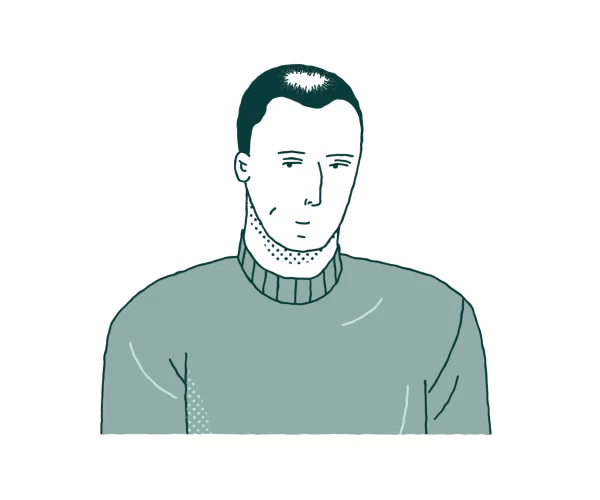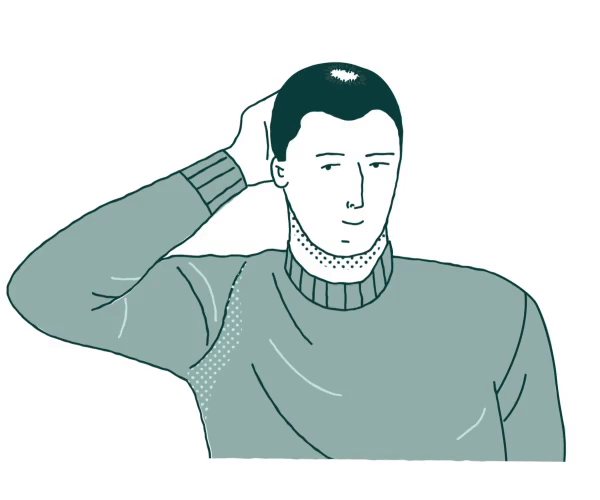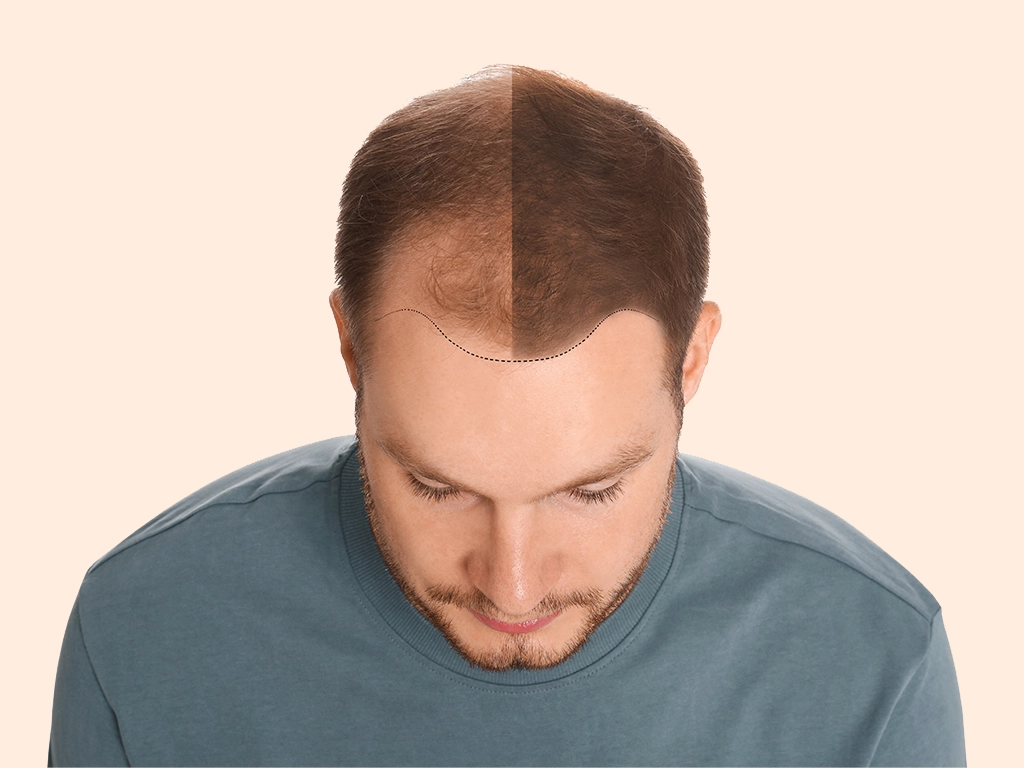Hair Transplant Recovery
Hair transplant surgery is a minimally invasive procedure and one of the most effective hair restoration surgeries available today. It is especially beneficial for people experiencing hair loss due to genetics, hormones, or trauma. The success of a hair transplant procedure, however, depends not only on the operation itself but also on how well patients manage the recovery period.
This guide explains the complete hair transplant recovery timeline, detailing what to expect in the first days, weeks, and months following a hair transplant.
Hair Loss After a Hair Transplant Recovery
Many patients feel worried when they see shedding during the early stages. However, this shedding process is a normal part of the transplant recovery. It is known as shock loss and occurs in almost all patients following a hair transplant. Shock loss is caused by the natural growth cycle of hair follicles transitioning into the resting phase due to surgical trauma. The actual follicular unit and bulb remain intact during shock loss.
During the first 2–4 weeks, the transplanted follicles enter a resting phase. As a result, the hair falls out while the scalp prepares for a new hair growth cycle. This phase is completely normal and signals that the scalp is adapting. Shock loss usually lasts up to two months. Only the hair shaft is released during the shock loss process.
When Do Hair Transplant Results and Hair Growth Appear?
The initial hair growth usually starts 3–4 months after surgery. At first, the new hair looks soft and thin. Over time, it becomes stronger and denser. During the first 4 to 5 months post-transplant, patients may notice a shedding process before new hair begins to grow. After shock loss, new hair growth typically begins around 3 to 4 months post-transplant.
- At 6 months, new hair growth increases significantly, with hair strands getting thicker and stronger. At this stage, hair growth is at its most rapid rate, and patients begin seeing significant coverage. The average patient sees 60-70% of new hair fully penetrate the scalp by 6-7 months after the procedure.
- At 9–12 months, patients see their final results, enjoying natural hair growth and a dense head of hair.
Therefore, anyone undergoing a FUE hair transplant or follicular unit transplantation should remain patient and carefully follow the aftercare advice. The exact hair transplant timeline depends on technique, scalp health, and lifestyle.
Stages of Hair Growth Cycle in Hair Transplant Recovery timeline
Hair growth occurs in defined stages after a hair transplant procedure:
- Week 1–2: Mild redness, swelling, and scabs in the transplanted area.
- Month 1–3: Shock loss; no visible newly transplanted hairs yet.
- Month 3–6: Newly transplanted hair grafts begin producing fine hair. Hair follicles adapt and strengthen.
- Month 6–12: Hair density improves, and the hair grows more naturally.
This hair transplant recovery process requires consistency but ultimately delivers a fuller head of hair.
Itching After a Hair Transplant
Itching is a common and positive sign of healing. However, scratching must be avoided. Use prescribed soothing sprays or antihistamine creams if necessary.
Washing Hair After a Hair Transplant
Begin washing the hair 48–72 hours post-surgery using a gentle medical shampoo. Avoid direct water pressure and scrubbing. Use lukewarm water and pat dry carefully. Patients are advised to wash their hair gently with recommended solutions after the first few days post-surgery.
What to Eat After a Hair Transplant
Diet directly affects healing and growth. Focus on:
- High-protein foods: eggs, lean meat, fish
- Iron-rich foods: spinach, legumes
- Zinc and biotin supplements
- Hydration: 2–3 liters of water per day
Exercise After a Hair Transplant
Light walking is allowed after 3–5 days. Avoid heavy workouts, weightlifting, or intense cardio for 2–3 weeks to prevent sweating and pressure on the scalp.
Smoking After a Hair Transplant
Avoid smoking for at least 1–2 weeks before and after surgery. Nicotine reduces blood flow, impairs healing, and may cause hair transplant failure. Patients are advised to keep their head elevated during sleep to minimize irritation and swelling in the donor and transplanted areas.
first 10 Days Hair Transplant Results
- Scabs fall off naturally
- Grafts are secure
- No new growth yet
- Minor redness may remain
Donor Area and Recovery Process After the First Month

At one month post-op:
- Most patients notice hair shedding, which is a normal part of the recovery process.
- Grafts at the donor site and donor area stabilize.
- Mild redness may persist, especially in sensitive skin types.
Therefore, sun protection and gentle hair wash routines are essential during this phase. Avoiding physical activities and sun exposure is recommended during the initial healing period following a hair transplant.
What Happens After the Third Month of Hair Transplant Recovery?

By the third month:
- New hair growth begins, though patchy at first.
- Some areas grow faster, producing uneven density.
- Patients report only minor symptoms such as itching.
Moreover, keeping the scalp hydrated and using prescribed shampoos support the healing process. Using topical anti-itch creams can alleviate increased itching after scabs on the scalp have fallen off or healed.
What Happens After the Sixth Month of Hair Transplant Recovery?

At this stage:
- Hair transplant results become more visible.
- The hair density improves, giving patients more hair coverage.
- The texture begins to resemble natural hair.
As a result, many patients feel confident even before reaching the final results at one year.
Side Effects During the Hair Transplant Procedure and Recovery
- Scaling and scabbing: Appear early; avoid scratching.
- Facial swelling: Temporary and reduces with care. Most swelling and redness should subside within the first week after a hair transplant.
- Mild symptoms: Such as itching or sensitivity.
- Mild pain: Easily managed with pain medication.
- Swelling and scabbing: Common within the first week after a hair transplant.
These issues are short-lived and usually present only minor symptoms during the recovery period.
Hair Transplant Aftercare – Washing and Protecting the Hair
Patients may perform the first hair wash 48–72 hours after surgery:
- Use sulfate-free shampoo.
- Rinse hair gently, avoiding direct water pressure.
- Pat dry carefully to protect newly transplanted hairs.
This forms an essential step of the hair transplant aftercare and overall aftercare process.
FUE Hair Transplant Procedure and Returning to Daily Life
- Work: Light office work after 3–5 days, physical jobs after 7–10 days.
- Exercise: Walking after 3 days; gyms after 2–3 weeks.
- Sleep: On your back with your head elevated for 7–10 days.
- Intimacy: Resume after 5–7 days.
- Follow-up care: Patients should hold regular check up appointments during the recovery timeline.
Hair Restoration Surgery – When Hair Transplant Results Fail
Although rare, hair transplant failure may occur due to infections, improper aftercare, or weak donor hair. Signs include:
- Lack of new hair growth after 6–8 months.
- Visible bald patches.
Therefore, patients must attend every follow up appointment and follow medical instructions closely. If needed, revision surgery restores coverage.
Hair Transplant Results and Hair Restoration After One Year
At 12 months:
- The final results become clear.
- Patients enjoy a thick head of hair with natural hair growth.
- The average patient reports higher confidence and long-term satisfaction. By one year after a hair transplant, desired results are typically achieved, with the hair appearing fuller and healthier.
- The final results become clear.
- Patients enjoy a thick head of hair with natural hair growth.
- The average patient reports higher confidence and long-term satisfaction.
Ensuring a Successful Hair Transplant Recovery
The hair transplant recovery timeline requires patience and discipline. By following the hair transplant aftercare plan, protecting the scalp with sun protection, and keeping up with follow up appointments, patients achieve durable results. The entire recovery process can take several months, with most noticeable healing occurring in the first few weeks.
Finally, ClinMedica offers a free consultation and initial consultation for anyone considering a FUE hair transplant procedure or other advanced hair transplantation procedures. This ensures patients understand the journey, the recovery period, and the steps needed to maintain a lifetime of strong, natural hair growth.
Frequently Asked Questions (FAQ) About Hair Transplant Recovery
When Can I Return to Work After a Hair Transplant?
Patients can return to desk jobs after 3–5 days. For physically demanding work or outdoor exposure, a recovery period of 7–10 days is ideal to protect the grafts.
When Can I Sleep on My Side After a Hair Transplant?
Sleep on your back with your head elevated for the first 7–10 days. Side or stomach sleeping may displace grafts and delay healing.
How Long Does Transplanted Hair Last?
Transplanted hair lasts a lifetime in most cases. The grafts are taken from donor zones genetically resistant to hair loss. Long-term care helps maintain results.
Does Transplanted Hair Fall Out Over Time?
It does not fall out like regular hair, but poor health, chronic stress, or scalp conditions can impact results. Maintaining a healthy lifestyle is key.
How to Care for Hair After a Hair Transplant ?
Proper care is essential. Follow these steps:
- Use gentle shampoos.
- Avoid scratching or picking.
- Protect the scalp from sun and dust.
- Keep the area moisturized.
- Avoid swimming or sauna for 2–3 weeks.

